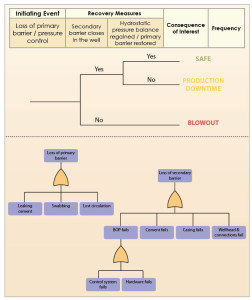Accident precursor program under development to prevent major hazards
By Smarty Mathew John, ABS; Ole Magnus Nyheim and Jan Dahlsveen, Safetec Nordic AS, ABS Group

It is rare for a major catastrophe to occur in isolation. Typically, major accidents are not caused by a single failure but by multiple failures occurring in sequence. Inquiries following catastrophes commonly have revealed evidence of missed signals, dismissed alerts, and indicators preceding the incident that should have raised a red flag. If these precursors had been detected and managed, the event might have been avoided.
In simple terms, precursors are operating events (deviations from normal) that could result in a high-severity consequence when coupled with one or more postulated events. Precursors include incidents, near-misses and unusual system conditions detected during operation, inspection, testing or engineering evaluation. Operational and organizational matters fall under this umbrella, as well.
While accidents are rare, precursors are common, and there is much to be learned from them. Studying precursors allows measures to be taken to prevent catastrophic events. Precursor analysis techniques have been applied successfully in the nuclear and aerospace industries, implying that a similar approach could be effective in managing major accident risk in offshore operations.
Applying ASP
ABS and Safetec Nordic AS, an ABS Group company, have been looking into applying an accident sequence precursor (ASP) program in the offshore industry. The goal is to determine the basic elements of an ASP program and to validate it through a well integrity application. The engineering team has developed a risk model for a well kick, including all of the relevant precursors, along with a preliminary set of risk-influencing factors – such as competence, time pressure, the cement program, etc – and how these factors influence the probability of the precursor event. Once validation has been completed on the well kick model, the next step will be to represent the events following a kick that results in a blowout.
Program Components
The essential elements of an ASP program include an operating event database, a screening method, a precursor analysis technique and a risk model.
The operating event database is a repository for all of the operating events that require further evaluation to determine their risk significance. Data can be gathered from near-miss reports, incident investigation reports, non-conformance reports, a mechanical integrity program, management of change (MoC) process documents, and classification society findings. External sources, such as industry safety alerts and bulletins, could also be part of the database.
There is obvious value in having near-miss reports on well integrity that report kicks within the kick margin during operations. For mechanical integrity program findings, that could include information regarding availability of rig-critical equipment or maintenance backlogs, and MoC reports that could provide information about changes to equipment, operations and organization.
The risk model
The use of a qualitative or quantitative risk model enables the credible scenarios leading to a consequence to be evaluated, along with the safeguards/barriers in place. A quantitative risk model can be used to represent the accident sequence and evaluate the likelihood of occurrence of the consequence in terms of frequencies.
The first step in developing the risk model is to identify all of the consequences of interest (COI), which could include major hazards, such as blowout, fire/explosion, structural failure, etc, and related accident sequences. The second step involves identifying the safeguards/barriers in place. Hazard identification techniques, such as HAZOP or What-If, can be used for the first two steps. When the consequences have been identified, a risk model representing all of the accident sequences can be developed using an event tree with linked fault trees, bow-tie or influence diagrams.
Barriers can vary based on well type (normal or HPHT) and operational phase (exploration, development, completion, workover, wireline). Bayesian updates can be used to combine the generic and rig data on barrier reliability.
Depending on the company’s reporting threshold, there is potential for a large number of operating events. Because precursor analysis is resource-intensive, it is crucial to remove any events that are non-risk significant, which can be achieved by applying screening criteria. Typical events to be screened in could include those involving rig-critical operations and related equipment and safety systems. To be most effective, these criteria would be defined based on the type of event being evaluated.
Assuming an acceptable frequency baseline for a COI can be established, the change in COI frequency could be estimated when there is an event or a condition. For example, if the baseline frequency for blowouts is estimated to be 10-x events/yr, and there is a BOP unavailability condition, the COI frequency changes (goes above the baseline value). This change is visible for the time during which the BOP is unavailable.

The risk significance of the precursor can be determined by mapping it onto the risk model to derive the conditional COI frequency. For a fleetwide assessment (several rigs monitored), the criteria could be:
High-risk precursor: Conditional COI frequency > baseline frequency
Medium-risk precursor: Conditional COI frequency < = baseline frequency.
Risk treatment could be appropriate based on precursor category. Trend assessment is recommended for an installation level assessment.
Looking ahead
ASP is a proactive risk management approach that has the potential to reduce the risk of catastrophic events through information gathered from operational experience. While progress has been made in applying ASP to offshore operations, there is a need for an industrywide effort in precursor data collection for well integrity events so the application of a quantitative risk model such as this can be validated.
This article is based on a presentation at the 2013 IADC HSE and Training Conference & Exhibition, 5-6 February, Houston.




